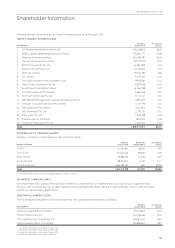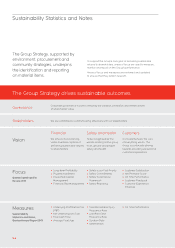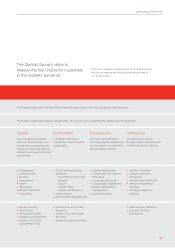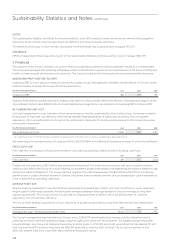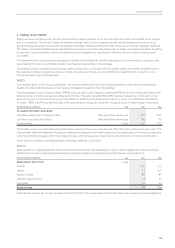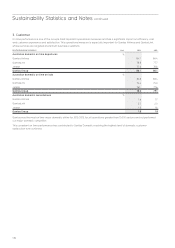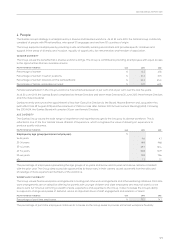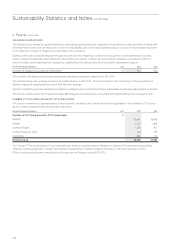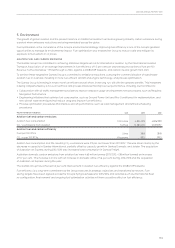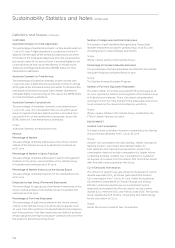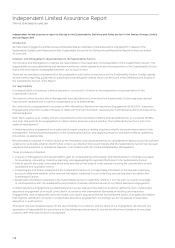Qantas 2013 Annual Report Download - page 177
Download and view the complete annual report
Please find page 177 of the 2013 Qantas annual report below. You can navigate through the pages in the report by either clicking on the pages listed below, or by using the keyword search tool below to find specific information within the annual report.
175
QANTAS ANNUAL REPORT 2013
Denitions and Scopes
FINANCIAL
Underlying Prot Before Tax (PBT)
Underlying PBT is a non-statutory measure, and is the primary
reporting measure used by the Qantas Group’s chief operating
decision-making bodies, being the Chief Executive Ofcer (CEO),
the Management Committee and the Board of Directors. The
objective of measuring and reporting Underlying PBT is to provide
a meaningful and consistent representation of the underlying
performance of each Segment and the Group.
Underlying PBT is derived by adjusting Statutory PBT for the
impacts of AASB 139 Financial Instruments: Recognition and
Measurement (AASB 139) which relate to other reporting periods
and identifying certain other items which are not included in
Underlying PBT.
A detailed denition, methodology and reconciliation of
Underlying PBT to Statutory PBT is contained in Note 2 to the
Financial Statements on page 112 of the Financial Report.
Net Underlying Unit Cost
The net underlying unit cost of the Group, which is the
Underlying PBT less passenger revenue and fuel, divided by
the Group’s Available Seat Kilometres (ASKs). Net underlying
expenditure is derived from total passenger revenue less
Underlying PBT.
Free Cash Flow
Free cash ow is a measure of nancial performance calculated
as operating cash ows net of investing cash ows.
Scope:
The Consolidated Financial Statements for the year ended
30June 2013 comprise Qantas and its controlled entities
andtheQantas Group’s interest in associates and jointly
controlled entities.
Average Fleet Age – Scheduled Passenger Fleet
The average age of the Group’s scheduled passenger eet
based on manufacturing dates.
Scope:
The scheduled passenger eet of the Qantas Group, including
both owned and leased aircraft. The Qantas Group’s scheduled
passenger eet does not include dedicated freighters and
Network Aviation eet.
SAFETY AND HEALTH
Total Recordable Injury Frequency Rate (TRIFR)
The total number of injuries or illnesses during work hours (1 July
to 30 June) with an accepted workers’ compensation claim for
Australian-based personnel, or equivalent in other jurisdictions,
per million hours worked. Journey and slip port injuries are
excluded from this calculation. This metric includes embedded
contractors that work exclusively for the Qantas Group and
perform work that is considered core business. Calculation is
based on injury record status as at 15 July 2013 (2012: 13 July 2012).
Lost Work Case Frequency Rate (LWCFR)
The total number of injuries or illnesses during work hours (1 July
to 30 June) with an accepted workers’ compensation claim for
Australian-based personnel, or equivalent in other jurisdictions,
which resulted in total incapacity, per million hours worked.
Total incapacity is dened as any injury or illness that results
in an injured worker being unt for work. Journey and slip port
injuries are excluded from this calculation. This metric includes
embedded contractors (as described above). Calculation is
based on injury record status as at 15 July 2013 (2012: 13 July 2012).
Duration Rate
The average number of lost days per injury/illness with an
accepted workers’ compensation claim for Australian-based
personnel, or equivalent in other jurisdictions, resulting in partial
incapacity or total incapacity. Partial incapacity means any
injury/illness that resulted in an injured/ill worker being t for
work but at a reduced capacity. Lost days means the number
of medically certied calendar days, including partial days, for
which the injured worker is unable to full the duties for which
they are employed (partial days are counted as one full day).
Journey and slip port injuries are excluded from this calculation.
This metric includes embedded contractors (as described above).
Workplace Health and Safety Fatality
The death of an employee or embedded contractor arising from
an occupational injury or disease sustained or contracted while
working for the Qantas Group in Australia and overseas.
Scope:
Employees and embedded contractors of wholly-owned entities
of the Qantas Group excluding Australian air Express.
Aviation Fatality
Fatal injuries as a result of being in Qantas Group aircraft or
having direct contact with any part of Qantas Group aircraft,
including parts which have become detached from the aircraft,
or direct exposure to jet blast except when the injuries are from
natural causes, self-inicted or inicted by other persons, or
when the injuries are to stowaways hiding outside the areas
normally available to the passengers and crew, or where
the fatality is recorded as an occupational health and safety
fatality. For statistical uniformity only, an injury resulting in death
within 30 days of the date of the accident is classied as a fatal
injury (adapted from Australian Transport Safety Bureau (ATSB)
and International Civil Aviation Organization (ICAO) denitions
for serious injuries resulting from aircraft events).
Scope:
Qantas Group branded aircraft.
Absenteeism
The average number of annualised days taken as sick leave
(including carer’s leave) per employee from 1 July to 30 June for
employees who are employed as at 30 June.
Scope:
All Australian and New Zealand-based employees of
wholly-owned entities of the Qantas Group.


